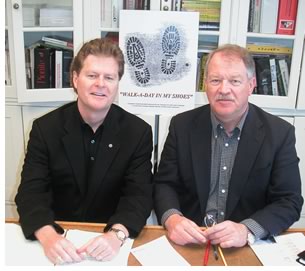

FROM
THE PRESIDENT’S OFFICE
Lessons From Atticus Finch

by Thompson E. Penney, FAIA
Recently, the American Film Institute (AFI) selected the top 100 heroes and villains (50 each) in the AFI’s 100-year history. Among the 50 contending good guys were Indiana Jones, Rocky Balboa, Robin Hood, Superman, and Moses. Trumping them all, however—even Moses—was Atticus Finch, the deeply principled and unassuming small-town lawyer in To Kill a Mockingbird, played by recently deceased Gregory Peck.
 In a time when
the usual Hollywood fare puts the stress on the superhuman (good or evil)
and easy moral choices, AFI’s announcement was as inspirational
as it was surprising. To Kill a Mockingbird
doesn’t have a single car chase, nothing blows up, nor does the
fate of the planet hang in the balance. And what can you say about the
“hero”? There’s no swordplay, no blaze of gunfire, and
no impossible feats of physical daring.
In a time when
the usual Hollywood fare puts the stress on the superhuman (good or evil)
and easy moral choices, AFI’s announcement was as inspirational
as it was surprising. To Kill a Mockingbird
doesn’t have a single car chase, nothing blows up, nor does the
fate of the planet hang in the balance. And what can you say about the
“hero”? There’s no swordplay, no blaze of gunfire, and
no impossible feats of physical daring.
The AFI press release made me want to reacquaint myself with Harper Lee’s novel, which I hadn’t picked up since high school English. I wanted to take a second look at this classic tale of prejudice, injustice, human frailty, and human nobility. What did the AFI jurors who cast their votes for Atticus Finch see as the defining traits of his particular kind of gentle heroism? Are there lessons from which we can learn?
Empathy and understanding
Perhaps even more than his profession as a lawyer, the character of Atticus
Finch is defined by his role as a father to his two children, Scout and
Jem. He knows in the most profound way that his actions even more than
his words will instill within them a system of values that will guide
them the rest of their lives.
 Because
he has personal and professional experience with the harm that people
can do, he is not naïve. Because he is open to his neighbor’s
goodness and small acts of charity, however, he is not cynical. Despite
the human capacity for great evil, he is determined to search for and
admire the good he believes is in all people. As much of a realist as
he is a man of ideals, he recognizes that holding a grudge for some wrong
done to you only prolongs the pain and destructiveness of a harmful act.
Because
he has personal and professional experience with the harm that people
can do, he is not naïve. Because he is open to his neighbor’s
goodness and small acts of charity, however, he is not cynical. Despite
the human capacity for great evil, he is determined to search for and
admire the good he believes is in all people. As much of a realist as
he is a man of ideals, he recognizes that holding a grudge for some wrong
done to you only prolongs the pain and destructiveness of a harmful act.
Most significantly, Atticus Finch practices empathy. He tells his children that if one lives one’s life with empathy and understanding, then it is possible to retain faith in humanity: “You never really understand a person until you consider things from his point of view . . . until you climb into his skin and walk around in it.”
Mockingbird vs.
Fountainhead
The creative power of empathy should speak especially forcefully to architects.
After all, how can we fully carry out our charge as designers to serve
human needs if we are not prepared to put ourselves in the shoes of our
clients and the users of the projects we design? Only when we understand,
truly understand the perspective
of the client as well as the public and, indeed, the community that constitutes
the entire design team will we be faithful to the great mission of our
profession.
Achieving that understanding requires more than lip service. Earlier this year, for example, Jack Kelley, national president of the Associated General Contractors (AGC), and I launched a program called “Walk a Day in My Shoes.” As the title makes clear, the purpose of this initiative is for architects and contractors to spend a day in each other’s office to gain an appreciation and new respect for what each of us brings to a project. Jack and I encourage similar “joint ventures” at the local level between AIA members and the members of AGC. For, as Atticus tells us, it is only by “climbing into the skin” that we open ourselves to the power and creative energy that come from understanding the other person’s point of view.
In our capacity as mentors to the generations of architects that will follow us (a part we inevitably play whether consciously or not), the quiet empathy of Atticus Finch and his commitment always to search out the good in others offer a more plausible and ultimately more effective model of professional conduct than the egotistical likes of a Howard Roark. Indeed, Howard Roark has much more in common with the villains identified in the AFI poll than the mockingbird in Ms. Lee’s tale, which, as we are reminded, sings not for itself, but to make beautiful music for the rest of us.
Postscript: Asked to give an example of a hero cast in the mold of Atticus Finch, I would without hesitation name former College of Fellows Chancellor Leslie Norwood Boney Jr., FAIA, who died in his beloved Wilmington, N.C., last month. Unassuming, deeply principled, and always eager to help others, Les left an abiding impression on everyone he met. During the funeral service that celebrated his life, his son asked a full sanctuary of over 1,000 people to raise their hands if they had ever received a letter from Les. Almost every hand went up. On the night he died, he was answering someone who had asked him what his guiding principle in life was. “I find,” he wrote, “that it is a good thing to be nice to people.”
Copyright 2003 The American Institute of Architects.
All rights reserved. Home Page ![]()
![]()
 |
||
| To find the AGC chapter office near you, use the AGC-chapter locator. During his visit to the firm run by AGC President Kelley (right, photo below), AIA President Penney rolled up his sleeves to get an appreciation of the intensity and competitive focus of putting together a project bid. Kelley will visit Penney’s firm later this year.
|
||